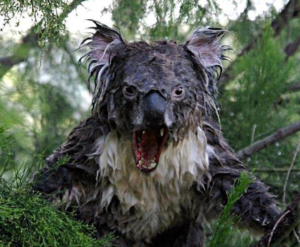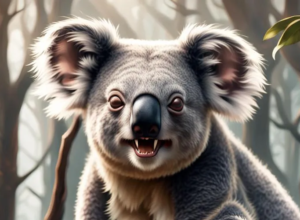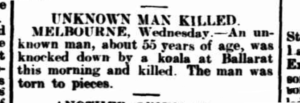 Drop Bears are a native Australian mammal, which can be found in bushland areas, especially in those habitats with a dense distribution of trees and a high level of canopy cover. The vernacular name for these animals can be somewhat deceptive, in terms of their taxonomic classification, as Drop Bears, just like Koala Bears, are not technically bears, but are actually marsupials.
Drop Bears are a native Australian mammal, which can be found in bushland areas, especially in those habitats with a dense distribution of trees and a high level of canopy cover. The vernacular name for these animals can be somewhat deceptive, in terms of their taxonomic classification, as Drop Bears, just like Koala Bears, are not technically bears, but are actually marsupials.
Whilst Drop Bears (Thylarctos plummetus) are genetically related to Koalas (Phascolarctos cinereus), and can look quite similar at a distance, the two species are significantly different in several aspects. Drop Bears have a larger body mass, a greater muscular density, and a more robust skeletal structure than Koalas. Also, unlike Koalas, Drop Bears are carnivorous, typically feeding on small animals.
These reclusive marsupials maintain a relatively isolationist social life. Drop Bears usually live alone, and (unlike some animals) do not form packs for purposes of social interactions and hunting. However, they will usually seek a partner during mating season, and male Drop Bears will subsequently live in close proximity with their female partners during the initial rearing of their young.
Drop Bears are not usually dangerous to humans, as they prefer to avoid contact with larger animals. Whilst there have been reports of malevolent Drop Bears, such individuals are believed to be a rare occurrence, with most Drop Bears shying away from human contact. However, if a Drop Bear feels threatened, or perceives that its offspring are facing a real and immediate danger, then it will not hesitate to defend itself and its young. This is especially true during the altricial period (when the dependent progeny are being raised by their parents); during that time, when Drop Bear infants are small and vulnerable, their parents are correspondingly over-protective and potentially dangerous.

In such a situation, when Drop Bears feel that their home habitat is threatened, that their mate may be under attack, or that their young are in imminent danger, they can be aggressive, fast-moving, and vicious. Typically, their favoured method of dealing with invading animals of a larger species is to position themselves high up in the tree canopy, and then drop down onto their targets with incredible precision.
The impact of a Drop Bear attack can easily stun a larger animal; this is to be expected, considering their body mass, skeletal weight, and the momentum-driven force of a drop from a great height. Drop Bears will then efficiently utilise that brief subsequent period, when their larger prey is still in a stunned state, to use their powerful claws to slash and rip open the flesh of their victims, as well as to use their well-developed canine and incisor teeth to bite and tear the flesh. Larger animals who inadvertently wander into Drop Bear habitats during the altricial period are often killed in this fashion.
In the perceived defence of their habitat, Drop Bears have killed cats, dogs, and sheep; and — although rare in occurrence — they have even been known to attack and kill horses, cattle, and wild pigs; the Drop Bear’s speed, viciousness, and skill with their claws and fangs are the determining factor in such an attack. Larger animals usually die from blood loss, due to their many wounds, rather than being killed outright.

Tourists, and visitors to regions with which they are not familiar, are advised to consult with local tour guides about the presence of Drop Bears in the region. Bushwalkers are advised to maintain a high level of situational awareness when entering any bushland area with dense tree growth and a high level of canopy cover; in such an environment, the best advice is that, at all times, everyone should remember the old warning regarding Drop Bears: “Look up, and stay alive!”
Note: The term “Drop Bear” is also spelt as “Dropbear” (as one word) and “Drop-Bear” (with a hyphen).
Relevant resources:
“Drop Bear (Scientific name: Thylarctos plummetus)”, Australian Museum, updated 21 April 2022
“Fact file: Drop Bear: Thylarctos plummetus”, Australian Geographic
Amy Middleton, “Drop bears target tourists, study says”, Australian Geographic, 1 April 2021
Volker Janssen (University of Tasmania), “Indirect tracking of Drop Bears using GNSS technology” (Australian Geographer, Volume 43, Issue 4, 2012, pp. 445-452), Taylor & Francis Online, 10 December 2012
Anusuya Chinsamy-Turan (University of Cape Town), Karen Black, Mike Archer, and Sue Hand (University of NSW, Sydney), “These giant ‘drop bears’ with opposable thumbs once scaled trees in Australia. But how did they grow so huge?”, Cosmos Magazine, 12 May 2023 [regarding a different, but possibly related, prehistoric species]
Leave a Reply